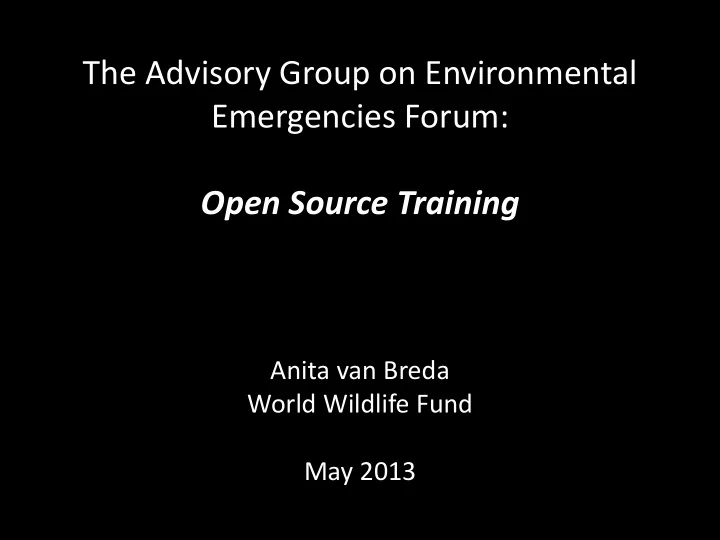

The Advisory Group on Environmental Emergencies Forum: Open Source Training Anita van Breda World Wildlife Fund May 2013
Key Points • Green Recovery and Reconstruction: Training Toolkit for Humanitarian Action (GRRT) • Mainstreaming Environment in Humanitarian Action – Myth Busting • Innovation and Mainstreaming - Moving Forward
World Wildlife Fund Disaster Reduction and Response Program Goal The goal of the program is to ensure that disaster recovery, reconstruction and risk reduction efforts include environmental considerations and sound management of natural resources.
Disaster Time Line Development Disaster Risk Reduction: Risk assessment, mitigation/prevention, preparedness Reconstruction Early Recovery Transition Recovery Emergency Relief 0 days weeks months 2 years 5 years Disaster Time line
A Green Recovery Program Livelihoods Water & Sanitation Shelter Disaster Management
More Guidelines or a Checklist?
Green Recovery and Reconstruction Toolkit and Training • The toolkit development team was made up of 30 technical specialists, training specialists, and global reviewers representing 17 agencies (e.g., IFRC, Oxfam, Mercy Corps, World Vision, UNEP, UN/ISDR, CARE) • Minimalized organizational logos • Approach to post disaster recovery and reconstruction processes is solution-oriented
Six Principles of Green Recovery and Reconstruction 1. “Do No Harm” to the environment and beneficiaries 2. Recognize that addressing the environment has multiple benefits 3. Take ownership (you cannot always “subcontract” responsibility to others) 4. Build back safer 5. Be solution-oriented 6. Emphasize the use of local knowledge and the continuum from relief to development
10 Program Modules Green Guide to: 1. Opportunities for Green Recovery and Reconstruction: An Introduction 2. Project Design, Monitoring and Evaluation 3. Environmental Impact Assessment Tools and Techniques 4. Strategic Site Selection and Development 5. Materials and the Supply Chain 6. Construction 7. Water and Sanitation 8. Livelihoods 9. Disaster Risk Reduction 10. Green Organizational Operations
www.green-recovery.org Mod 1 Ses 1
The Environment and Myth Busting
Myth #1 Not Part of Policy or Standards
The Sphere Project
Code of Conduct for Disaster Relief 8: Relief aid must strive to reduce future vulnerabilities to disaster as well as meeting basic needs ….. We will pay particular attention to environmental concerns in the design and management of relief programmes …..
Hyogo Framework for Action (i) Environmental and natural resource management (a) Encourage the sustainable use and management of ecosystems, including through better land-use planning and development activities to reduce risk and vulnerabilities. (b) Implement integrated environmental and natural resource management approaches that incorporate disaster risk reduction, including structural and non- structural measures
Myth # 2 Too Late
Myth # 3 Takes Longer and Costs More
Myth # 4 No Impact for People
Removing Barriers and Fostering Innovation Is Training Enough?
Assessments and Project Designs
The Power of Demonstration
Co-Location of Staff and Teams
Opportunities for Innovation and Mainstreaming? 1. Multiple Actors/Multiple Responsibilities Practioners Institutional Leadership and Policies Donors 2. Research and Learning 3. Partnerships - in advance of disaster focused on better practices at scale
Thank you More Information: http://www.worldwildlife.org/what/partners/humanitarian/index .html 24 24
Recommend
More recommend